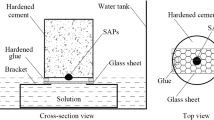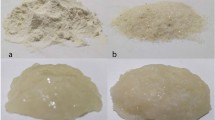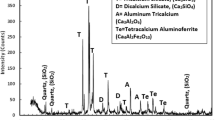Abstract
Superabsorbent polymer (SAP) is usually used as an internal curing agent for concrete, while its water absorption and desorption properties could affect the rheology of cement-based materials. In this paper, the effects of different SAP particle size, content and extra water on the apparent viscosity of cement paste over time were studied. Further, the correlation between plastic viscosity, yield stress and apparent viscosity was evaluated. The results show that the SAP particle size had a significant impact on the apparent viscosity of cement paste, and the larger the particle size of SAP, the more obvious the change of water absorption and desorption. The addition of SAP and extra water would reduce the plastic viscosity and yield stress of the cement paste to promote its fluidity. At the same time, the correlation coefficients of apparent viscosity, plastic viscosity and yield stress of SAP cement paste with different content and particle size were all above 0.93. Therefore, apparent viscosity not only could explain the water absorption and desorption kinetics of SAP in cement paste well, but also could be used as an evaluation index for the rheological properties of cement-based materials cured in SAP.












Similar content being viewed by others
References
Liu J, Shi C, Ma X et al (2019) An overview on the effect of internal curing on shrinkage of high performance cement-based materials. Constr Build Mater 146:702–712
Zhang X, Liu Z, Wang F (2019) Autogenous shrinkage behavior of ultra-high performance concrete. Constr Build Mater 226:459–468
De la Varga I, Castro J, Bentz D et al (2012) Application of internal curing for mixtures containing high volumes of fly ash. Cem Concr Compos 34(9):1001–1008
Jensen OM, Hansen PF (2002) Water-entrained cement-based materials. II. Experimental observations. Cem Concr Res 32:973–978
Justs J, Wyrzykowski M, Bajare D et al (2015) Internal curing by superabsorbent polymers in ultra-high performance concrete. Cem Concr Res 76:82–90
Mechtcherine V, Reinhardt HW (2012) Application of super absorbent polymers (SAP) in concrete construction: state-of-the-art report prepared by technical committee 225-SAP. Mater Struct 54:80
Kang SH, Hong SG, Moon J (2017) Absorption kinetics of superabsorbent polymers (SAP) in various cement-based solutions. Cem Concr Res 97:73–83
Agostinho LB, Alexandre CP, Silva E et al (2021) Rheological study of Portland cement pastes modified with superabsorbent polymer and nanosilica. J Build Eng 34:102024
Farzanian K, Ghahremaninezhad A (2018) Desorption of superabsorbent hydrogels with varied chemical compositions in cementitious materials. Mater Struct 51:3
Farzanian K, Ghahremaninezhad A (2018) On the effect of chemical composition on the desorption of superabsorbent hydrogels in contact with a porous cementitious material. Gels 4(3):70
Liu J, Khayat KH, Shi C (2020) Effect of superabsorbent polymer characteristics on rheology of ultra-high performance concrete. Cem Concr Compos 112:103636
Ma X, Yuan Q, Liu J et al (2019) Effect of water absorption of SAP on the rheological properties of cement-based materials with ultra-low w/b ratio. Constr Build Mater 195:66–74
Geng J, Chen M, Shang T et al (2019) The performance of super absorbent polymer (SAP) water-retaining asphalt mixture. Materials 12(12):1964
Farzanian K, Ghahremaninezhad A (2011) Superabsorbent polymers: on their interaction with water and pore fluid. Cem Concr Compos 33(7):717–724
Schröfl C, Mechtcherine V, Gorges M (2012) Relation between the molecular structure and the efficiency of superabsorbent polymers (SAP) as concrete admixture to mitigate autogenous shrinkage. Cem Concr Res 42(6):865–873
Meng W, Khayat KH (2017) Improving flexural performance of ultra-high-performance concrete by rheology control of suspending mortar. Composites B 117:26–34
Nanthagopalan P, Haist M, Santhanam M et al (2008) Investigation on the influence of granular packing on the flow properties of cementitious suspensions. Cem Concr Compos 30:763–768
Laskar AI, Talukdar S (2008) Rheological behavior of high performance concrete with mineral admixtures and their blending. Constr Build Mater 22:2345–2354
Lura P, Lothenbach B, Miao C et al (2010) Influence of pore solution chemistry on shrinkage of cement paste. In: The 50-year teaching and research anniversary of Prof. Sun Wei on advances in civil engineering materials. RILEM Publications SARL, Nanjing, pp 191–200
Vikan H, Justnes H, Winnefeld F et al (2007) Correlating cement characteristics with rheology of paste. Cem Concr Res 37(11):1502–1511
Snoeck D, Schaubroeck D, Dubruel P et al (2014) Effect of high amounts of superabsorbent polymers and additional water on the workability, microstructure and strength of mortars with a water-to-cement ratio of 0.50. Constr Build Mater 72:148–157
Min Li, Yu-jiang W, Wen-bin W et al (2016) Quantitative characterisation of absorption capacity and dosage of SAP in cement paste. Adv Cem Res 28(8):518–528
Mechtcherine V, Secrieru E, Schröfl C (2015) Effect of superabsorbent polymers (SAPs) on rheological properties of fresh cement-based mortars—development of yield stress and plastic viscosity over time. Cem Concr Res 67:52–65
Paiva H, Esteves LP, Cachim PB et al (2009) Rheology and hardened properties of single-coat render mortars with different types of water retaining agents. Constr Build Mater 23(2):1141–1146
Jensen OM, Hansen PF (2001) Water-entrained cement-based materials I. Principles and theoretical background. Cem Concr Res 31(4):647–654
Schröfl C, Snoeck D, Mechtcherine V (2017) A review of characterisation methods for superabsorbent polymer (SAP) samples to be used in cement-based construction materials: report of the RILEM TC 260-RSC. Mater Struct 197:50
Ma X, Zhang J, Liu J (2015) Review on superabsorbent polymer as internal curing agent of high performance cement-based material. J Chin Ceram Soc 43(8):1099–1110
Roussel N, Stéfani C, Leroy R (2005) From mini-cone test to Abrams cone test: measurement of cement-based materials yield stress using slump tests. Cem Concr Res 35:817–822
Lh A, Df A, Ak B (2020) How do different testing procedures affect the rheological properties of cement paste? Cem Concr Res 137:106189
Jin Y (2017) Microstructure and performance of cementitious materials internally cured by superabsorbent polymers. Wuhan University of Technology, Wuhan
Roussel N (2006) A thixotropy model for fresh fluid concretes: theory, validation and applications. Cem Concr Res 36:1797–1806
Yim HJ, Kim JH, Shah SP (2013) Cement particle flocculation and breakage monitoring under Couette flow. Cem Concr Res 53:36–43
Wang F, Yang J, Cheng H et al (2015) Study on mechanism of desorption behavior of saturated superabsorbent polymers in concrete. ACI Mater J 112:463–470
Zhu Q, Barney CW, Erk KA (2015) Effect of ionic crosslinking on the swelling and mechanical response of model superabsorbent polymer hydrogels for internally cured concrete. Mater Struct 48(7):2261–2276
Esteves LP (2011) Superabsorbent polymers: on their interaction with water and pore fluid. Cem Concr Compos 33:717–724
Mönnig S (2009) Superabsorbing additions in concrete applications, modeling and comparison of different internal water sources. Stuttgart University, Stuttgart
Mounanga P, Khelidj A, Loukili A et al (2004) Predicting Ca(OH)2 content and chemical shrinkage of hydrating cement pastes using analytical approach. Cem Concr Res 34(2):255–265
Brüdern AE, Mechtcherine V (2010) Multifunctional use of SAP in strain-hardening cement-based composites. In: International RILEM conference on use of superabsorbent polymers and other new additives in concrete. RILEM Publications S.A.R.L, Lyngby, pp 11–22
Lothenbach B, Winnefeld F, Alder C et al (2007) Effect of temperature on the pore solution, microstructure and hydration products of Portland cement pastes. Cem Concr Res 37(4):483–491
Zhang Shouqi Lu, Zhenbao AY et al (2020) Effect of super-absorbent polymer water absorption characteristics on performance of concrete. J Chin Ceram Soc 48(08):1278–1284
Acknowledgements
This research is supported by Ningbo Science and Technology Innovation 2025 Major Special Project (2019B10048), Jiangxi Transportation Science and Technology Project (2016C0005), Key R&D Program Funding Project of Shaanxi Province (2018SF-380) and the Special Fund for Basic Scientific Research of Central Colleges, Chang’an University (300102310301, 300102311404).
Author information
Authors and Affiliations
Corresponding authors
Ethics declarations
Conflict of interest
The authors declared that they have no conflicts of interest to this work. We declare that we do not have any commercial or associative interest that represents a conflict of interest in connection with the work submitted.
Additional information
Publisher's Note
Springer Nature remains neutral with regard to jurisdictional claims in published maps and institutional affiliations.
Rights and permissions
About this article
Cite this article
Geng, J., He, L., Chen, M. et al. Applicability of rheological properties of superabsorbent polymer cement-based materials using apparent viscosity. Mater Struct 55, 79 (2022). https://doi.org/10.1617/s11527-022-01924-w
Received:
Accepted:
Published:
DOI: https://doi.org/10.1617/s11527-022-01924-w




